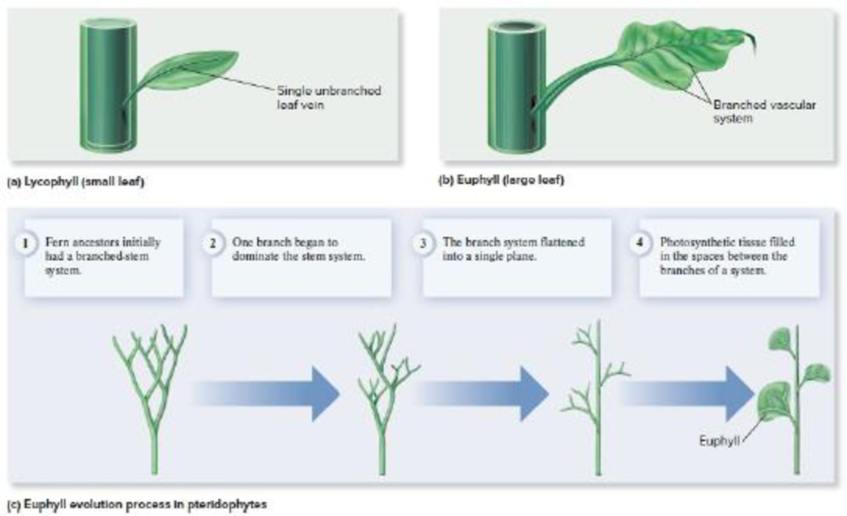
Concept explainers
Core Skill: Modeling The goal of this modeling challenge is to propose a visual model that compares the density of leaf veins between ferns and another plant group.
Modeling Challenge: Figure 31.21 provides a model of the process by which fern leaves having branched vascular systems (euphylls) are hypothesized to have evolved from ancestors with branching stems. Imagine that the leaves of some other plant group evolved similarly, but from stem systems that were twice as highly branched. In other words, when flattened, the stem system ancestral to this other plant group had twice as many branches per unit area. Assuming that the branch density of ancestors is directly related to vein density of leaves in descendant plants, draw a pair of models that compare the leaves of ferns and this other plant group, emphasizing the vein density in each type of leaf. How does the venation differ in the two leaf models?

Figure 31.21 Lycophylls and euphylls. (a) Most lycophylls possess only a single unbranched leaf vein with limited conduction capacity, explaining why lycophylls are generally quite small. (b) Euphylls possess branched vascular systems with greater conduction capacity, explaining why many euphylls are relatively large. (c) Fossil evidence suggests how
Want to see the full answer?
Check out a sample textbook solution
Chapter 31 Solutions
Biology
- Test Your Understanding Evaluate and Synthesize 18. EVOLUTION LINK Where would you place the progymnosperms on Figure 28-2? Explain your reasoning. Figure 28-2 Gymnosperm and angiosperm evolution This cladogram shows a current hypothesis of phylogenetic relationships among living seed plants, based on structural evidence, molecular comparisons, and fossils. Relationships among extant gymnosperm clades and angiosperms remain controversial. The arrangement of the phyla shown here may change as future analyses help clarify relationships.arrow_forwardKnow and Comprehend 12. Which of the following statements about ferns is not true? (a) ferns have motile sperm cells that swim through water to the egg-containing archegonium (b) ferns are vascular plants (c) ferns are the most economically important group of bryophytes (d) the fern sporophyte consists of a rhizome, roots, and fronds (e) the diversity of ferns is greatest in the tropicsarrow_forwardLesson: Perpetuation of life Assessment: Enumerate what is/are being asked. Give at least five examples of genetic engineered plants/animals. a. b. c. d. e. Give at least 2 examples of the following: Fission- - Budding- - Fragmentation- - 3. Give at least 4 examples of plants which can do Vegetative Reproduction. a. b. c. d.arrow_forward
- A. Identify plant groups using plant key characteristics.1. Fill in the blanks with what plant group is best described by the statement (hornworts, liverworts, ferns, cycads, conifers, monocots, and etc.).a. Vascular tissue present, dominant sporophyte, seedless with: Have large fronds and sori. What is this? Have club-like strobilus. What is this? Stems with no leaves, whisk-like appearance. What is this? b. Vascular tissue present, dominant sporophyte, develop seeds with: Needle-like leaves, with cones at the branches. What is this? Palm-like leaves, with cones in the center. What is this? c. No vascular tissue, have microphylls, dominant gametophyte with: Hornlike structures as the sporophyte. What is this? Cup-like structures in thallus called gemmae. What is this? Have simple conductive cells for nutrient transport. What is…arrow_forwardTest Your Understanding Evaluate and Synthesize 14. VISUALIZE construct a cladogram based on the following data. Mosses are plants with no vascular tissue. Horse-tails, ferns, gymnosperms (pines and other plants with naked seeds), and angiosperms (flowering plants) are all vascular plants. Seeds are absent in all but the gymnosperms and angiosperms. Angiosperms are the only seed plants with flowers. (Hint: To help you construct the cladogram, draw a simple table showing which characters are present in each group. See Fig. 23-9.) Figure 23-9 Constructing a cladogram using outgroup analysisarrow_forwardMAKE CONNECTIONS In addition to cotyledon number, how do thestructures of monocots and eudicots differ? (See Figure 30.16.)arrow_forward
- Please type a brief definition of the following terms Photoperiod - Long day vs. Short day vs. Day-neutral plants - Merosity - Quartet model - Orthologs - Microsporangium - Staminode - Self-incompatibility (SI) - Aggregate vs. multiple fruits - Homology vs. Homoplasy -arrow_forwardTest Your Understanding Know and Comprehend 1. Seed plants lack which of the following structure(s)? (a) ovules surrounded by integuments (b) microspores and megaspores (c) vascular tissues (d) a large, nutritionally independent sporophyte (e) a large, nutritionally independent gametophytearrow_forwardEvaluate and Synthesize 15. INTERPRET DATA According to the cladogram in Figure 27-5, which plants evolved first: nonvascular bryophytes, seedless vascular plants, or seed plants?arrow_forward
- Queation #1. Describe the different orders under the monocots in terms of plant habit, reproductive type (monoecius/dioecius), leaf type, leaf shape, floral characteristics, fruit morphology, seed size/shape, and other distinct features. Question #2. Identify the economic uses of at least 3 species in each order under the monocots. Question #3. Discuss the importance of several species of monocots in relation to the existence of human race. Do you think they are vital to our survival?arrow_forwardWhat sorts of anatomical contrasts would you expect between the upper and lower surfaces of a floating leaf plant like water lily? What competitive advantage would be gained by a plant that has colored leaves? Think about where you personally have encountered spiny plants like Swamps, Pastures Thickets, and Deep shade under hardwoods?arrow_forwardLignin and vascular tissue first evolved in relatives of club moss, and some extinct species stood 40 meters (130 feet) high. Explain how the evolution of vascular tissues and lignin would have allowed a dramatic increase in plant height. How might being tall give one plant species a competitive advantage over another?arrow_forward
 Biology (MindTap Course List)BiologyISBN:9781337392938Author:Eldra Solomon, Charles Martin, Diana W. Martin, Linda R. BergPublisher:Cengage Learning
Biology (MindTap Course List)BiologyISBN:9781337392938Author:Eldra Solomon, Charles Martin, Diana W. Martin, Linda R. BergPublisher:Cengage Learning Biology: The Dynamic Science (MindTap Course List)BiologyISBN:9781305389892Author:Peter J. Russell, Paul E. Hertz, Beverly McMillanPublisher:Cengage Learning
Biology: The Dynamic Science (MindTap Course List)BiologyISBN:9781305389892Author:Peter J. Russell, Paul E. Hertz, Beverly McMillanPublisher:Cengage Learning

